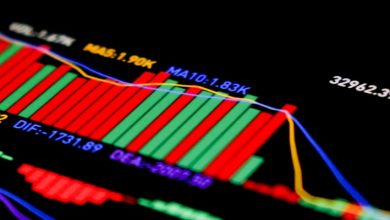What Are Crypto Derivatives and How Do They Work?

- Understanding the basics of crypto derivatives
- Exploring the different types of crypto derivatives available
- How leverage and margin trading play a role in crypto derivatives
- The risks and benefits of trading crypto derivatives
- Key factors to consider before investing in crypto derivatives
- Regulatory considerations for crypto derivatives in the financial market
Understanding the basics of crypto derivatives
Crypto derivatives are financial contracts that derive their value from an underlying cryptocurrency asset. These derivatives allow investors to speculate on the price movements of cryptocurrencies without actually owning the assets themselves. Understanding the basics of crypto derivatives is essential for anyone looking to get involved in this market.
There are several types of crypto derivatives, including futures, options, swaps, and contracts for difference (CFDs). Each type of derivative has its own unique characteristics and risk profile. Futures contracts, for example, obligate the parties involved to buy or sell the underlying asset at a predetermined price on a specified date in the future.
Options contracts, on the other hand, give the holder the right, but not the obligation, to buy or sell the underlying asset at a specified price within a certain timeframe. Swaps are agreements between two parties to exchange cash flows based on the price movements of the underlying asset. CFDs are contracts that allow investors to speculate on the price movements of cryptocurrencies without actually owning the assets.
By using crypto derivatives, investors can hedge their positions, speculate on price movements, and gain exposure to cryptocurrencies without actually owning them. However, it’s important to understand the risks involved in trading derivatives, as they can be highly leveraged and volatile. It’s essential to do thorough research and understand how each type of derivative works before getting involved in this market.
Exploring the different types of crypto derivatives available
Cryptocurrency derivatives come in various forms, providing investors with different ways to speculate on the price movements of digital assets. Some of the most common types of crypto derivatives include futures contracts, options, and swaps.
Futures contracts are agreements between two parties to buy or sell an asset at a specified price on a predetermined date in the future. This type of derivative allows investors to hedge their positions or bet on the future price of a cryptocurrency without actually owning the underlying asset.
Options are another popular type of crypto derivative that give investors the right, but not the obligation, to buy or sell an asset at a predetermined price before a specified expiration date. This provides traders with more flexibility in their trading strategies and allows them to manage risk more effectively.
Swaps are derivative contracts that involve the exchange of cash flows between two parties based on the price movements of an underlying asset. This type of derivative is often used for speculative purposes or to hedge against price fluctuations in the cryptocurrency market.
Overall, exploring the different types of crypto derivatives available can help investors diversify their portfolios and take advantage of various trading opportunities in the ever-evolving digital asset space. Whether you’re looking to hedge your positions, speculate on price movements, or manage risk, there’s a crypto derivative out there to suit your needs.
How leverage and margin trading play a role in crypto derivatives
Leverage and margin trading are important components of crypto derivatives, allowing traders to amplify their positions in the market. Leverage allows traders to borrow funds to increase their exposure to assets, potentially leading to higher profits or losses. Margin trading involves using borrowed funds from a broker to trade financial assets. In the world of crypto derivatives, leverage and margin trading play a significant role in enabling traders to take larger positions than their initial capital allows.
When trading crypto derivatives with leverage, traders can magnify their potential returns, as gains or losses are calculated based on the total position size rather than the initial investment. However, it is essential to proceed with caution when using leverage, as it also amplifies the risks involved in trading. Margin trading, on the other hand, allows traders to access additional funds to open larger positions than they could with their own capital alone.
By utilizing leverage and margin trading strategies in crypto derivatives, traders can maximize their profit potential while managing their risk exposure. It is crucial for traders to have a solid understanding of how leverage and margin trading work before engaging in these practices, as they can result in significant gains or losses depending on market conditions. Overall, leverage and margin trading are powerful tools that can help traders navigate the complex world of crypto derivatives with precision and efficiency.
The risks and benefits of trading crypto derivatives
Trading crypto derivatives can offer significant opportunities for investors to profit from the price movements of cryptocurrencies. However, it also comes with its own set of risks and benefits that traders need to be aware of before engaging in this type of trading.
One of the main benefits of trading crypto derivatives is the potential for higher returns compared to spot trading. Derivatives allow traders to use leverage, which means they can control a larger position with a smaller amount of capital. This can amplify profits if the trade goes in the trader’s favor.
On the other hand, trading crypto derivatives also comes with increased risks. Leverage can magnify losses as well as gains, so traders need to be cautious and manage their risk effectively. Additionally, the crypto market is known for its volatility, which can lead to rapid and significant price fluctuations in a short period of time.
Another benefit of trading crypto derivatives is the ability to hedge against price risk. Traders can use derivatives to protect their portfolios from adverse price movements by taking positions that will offset potential losses in their spot holdings. This can provide a level of insurance against market volatility.
However, it’s important to note that trading crypto derivatives requires a good understanding of the market and the instruments being traded. Traders need to be familiar with the various types of derivatives available, such as futures, options, and swaps, as well as the mechanics of how they work.
Key factors to consider before investing in crypto derivatives
Investing in crypto derivatives can be a lucrative opportunity, but it also comes with its own set of risks. Before diving into this complex financial instrument, it is important to consider key factors that can impact your investment decisions. One crucial aspect to keep in mind is the volatility of the cryptocurrency market. As prices can fluctuate rapidly, it is essential to have a clear risk management strategy in place. Additionally, understanding the terms and conditions of the derivative contracts is crucial to avoid any unexpected surprises. Conducting thorough research on the platform you plan to use for trading derivatives is also important to ensure its reliability and security. Furthermore, having a solid understanding of the underlying assets of the derivatives you are interested in is essential for making informed investment choices. By carefully considering these factors, you can better navigate the world of crypto derivatives and potentially increase your chances of success in this market.
Regulatory considerations for crypto derivatives in the financial market
When it comes to crypto derivatives in the financial market, there are several regulatory considerations that need to be taken into account. These derivatives, which are financial contracts whose value is derived from an underlying asset, such as Bitcoin or Ethereum, have gained popularity in recent years. However, regulators have expressed concerns about the potential risks associated with these complex financial instruments.
Regulatory bodies around the world are still grappling with how to classify and regulate crypto derivatives. Some countries have taken a cautious approach, imposing strict regulations to protect investors from potential fraud and manipulation. Others have taken a more hands-off approach, allowing the market to develop with minimal interference. It is essential for market participants to understand the regulatory landscape in their jurisdiction and ensure compliance with all relevant laws and regulations.
One of the main concerns regulators have with crypto derivatives is the lack of transparency in the market. Unlike traditional financial markets, where trading is conducted on regulated exchanges, crypto derivatives are often traded on unregulated platforms. This lack of oversight can make it difficult for regulators to monitor trading activity and detect market manipulation.
Another key consideration for regulators is the potential impact of crypto derivatives on market stability. The high volatility of cryptocurrencies, combined with the leverage offered by derivatives, can amplify price swings and increase the risk of cascading liquidations. Regulators are keen to prevent excessive risk-taking and protect the broader financial system from potential systemic risks.



